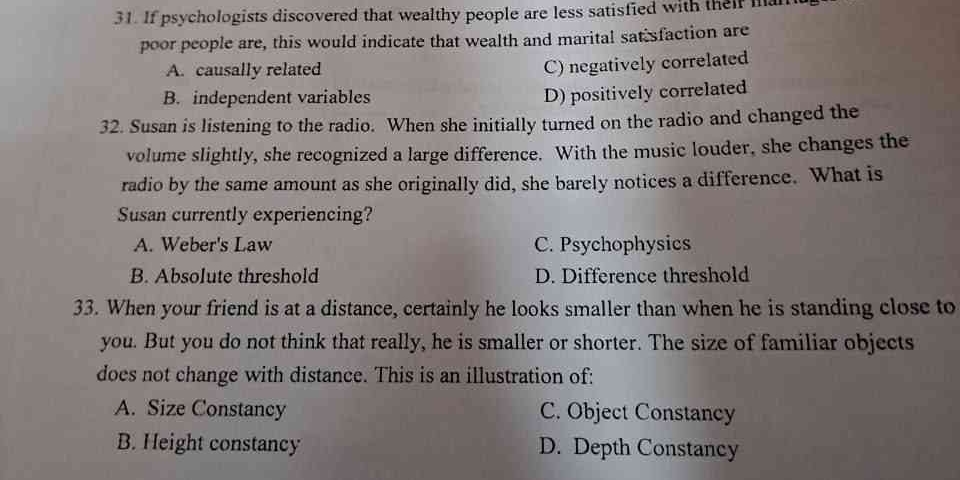31. If psychologists discovered that wealthy people are less satisfied with their marriages than poor people are, this would indicate that wealth and marital satisfaction are: A. c... 31. If psychologists discovered that wealthy people are less satisfied with their marriages than poor people are, this would indicate that wealth and marital satisfaction are: A. causally related B. independent variables C. negatively correlated D. positively correlated 32. Susan is listening to the radio. When she initially turned on the radio and changed the volume slightly, she recognized a large difference. With the music louder, she changes the radio by the same amount as she originally did, she barely notices a difference. What is Susan currently experiencing? A. Weber's Law B. Absolute threshold C. Psychophysics D. Difference threshold 33. When your friend is at a distance, certainly he looks smaller than when he is standing close to you. But you do not think that really, he is smaller or shorter. The size of familiar objects does not change with distance. This is an illustration of: A. Size Constancy B. Height constancy C. Object Constancy D. Depth Constancy

Understand the Problem
The image contains multiple choice questions related to psychology.
Question 31 explores the relationship between wealth and marital satisfaction, asking about the type of correlation implied if wealthier individuals report lower satisfaction in their marriages compared to those with less wealth.
Question 32 presents a scenario about Susan's perception of loudness changes in the radio, requiring identification of the psychological principle or phenomenon she's experiencing.
Question 33 describes a scenario regarding the perception of an individual's size at varying distances, prompting the identification of the perceptual constancy at play.
Answer
31. C, 32. A, 33. A
The answer to question 31 is C. The answer to question 32 is A. The answer to question 33 is A.
Answer for screen readers
The answer to question 31 is C. The answer to question 32 is A. The answer to question 33 is A.
More Information
Question 31: A negative correlation means that as one variable increases, the other decreases. Question 32: Weber's Law states that the just noticeable difference is a constant proportion of the original stimulus intensity. Question 33: Size constancy is a type of perceptual constancy that allows us to perceive objects as maintaining a stable size despite differences in distance.
Tips
Be sure to understand the definitions of the psychological terms.
Sources
AI-generated content may contain errors. Please verify critical information